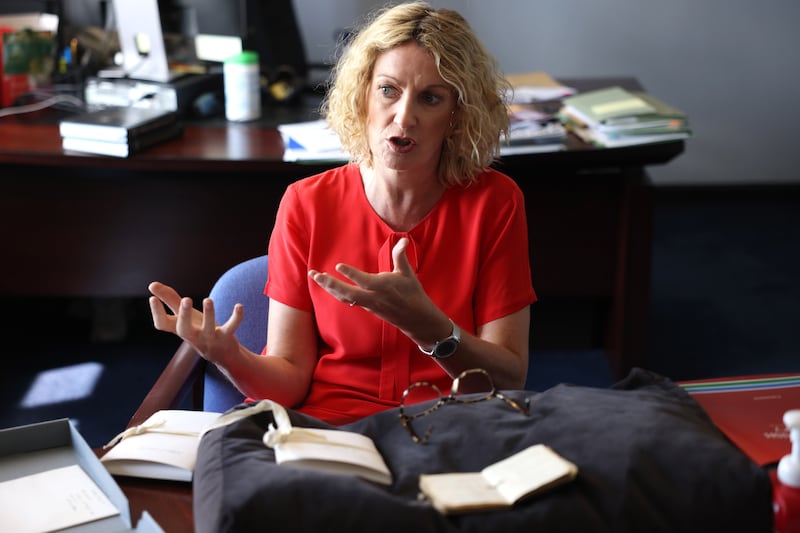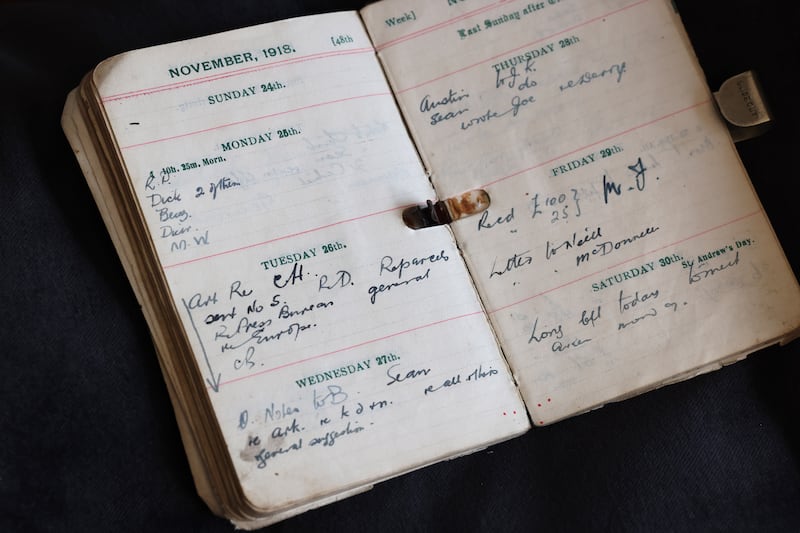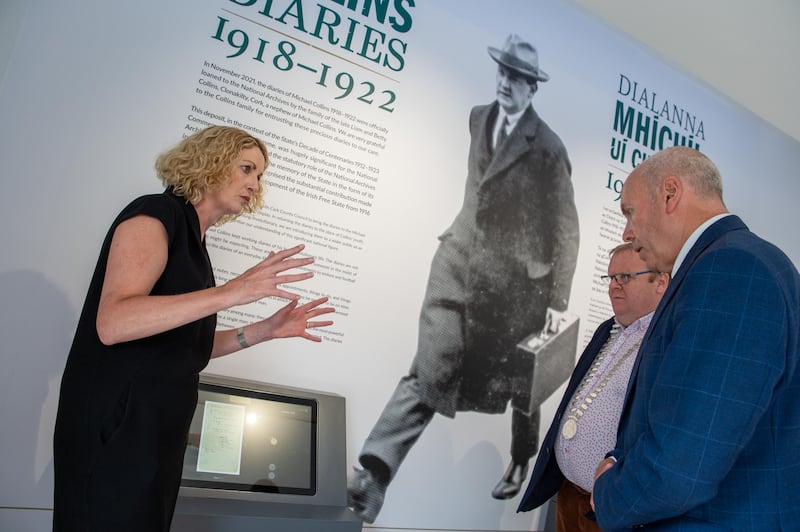There is no life in Irish history better chronicled than the life of Michael Collins. There is according, to some accounts, at least 65 biographies of him in existence not including books where some aspects of his political or military career are analysed.
Michael Collins the movie is 25 years old and still bears repeated viewing. Recently Newstalk listeners voted Collins the greatest Irish hero in the last century.
Collins has left behind a rich archive. His ceaseless activity in the service of Ireland generated hundreds of letters, memoranda, notes, speeches and interviews which have been scrutinised over the last century.
He is such a colossal figure in Irish history that it is easy to forget that he died tragically and too young at the age of 31. Those activities which made him world famous were packed into the five tumultuous years of the Irish Revolution between 1917 and 1922.
RM Block
We thought we knew everything there is to know about Collins and that there were no primary sources left to interrogate. That was until the family of his late nephew, Liam Collins, and his wife Betty handed over five diaries from 1918 through to 1922 which belonged to Collins and which were in the family’s safe keeping for the last 100 years.

They deposited the diaries with the National Archives last November. Two of the diaries between 1921 and 1922 have gone on display at the Michael Collins House Museum in Clonakilty, the other three are on deposit at the National Archives. They will become available to scholars to peruse in due course.
National Archives director Orlaith McBride says the diaries reveal an “extraordinarily busy man – the diaries show us somebody who is meticulous in terms of record keeping. He kept records of everybody he met.
“Michael Collins is writing down every pound and shilling he was getting from people around the country. We hope that it will allow people to understand a little more of this extraordinary man and this complex period in the life of the nation.”
His entries are not confessional as one might expect from literary or historical diaries. In the past many important people kept diaries, some for personal reasons, others with a view to making money out of them at a later date or to explain to future generations the thought processes that led them to make the decisions they made.
Diaries are a vanishing art in the modern age (Alastair Campbell’s Downing Street diaries being an exception) as are written correspondence which reveal what the person was really thinking.
The Michael Collins diaries, except in occasional flashes, do not conform to the confessional template, but they are interesting for all that in helping us to recall the dynamic leader who galvanised a whole nation and who appeared to inspire such admiration in those who supported him.

They show a human side to him. Several entries show him bothered by a toothache, another has him in bed for several days in February 1919, possibly with the Spanish Flu, and a third diary entry, one from April 14th, 1919, will bring a flash of recognition to those who have ever tried to quit smoking. Collins writes: “Stopped cigarettes today”.
They tell us a lot about his priorities and about the things he chose to remember. Collins was many things to many people and often all at once. He was at one stage minister for finance in Dáil Éireann in charge of the Dáil loan, director of intelligence in the IRA and the president of the Irish Republican Brotherhood (IRB) during the War of Independence all the while being on the run from the British authorities. After the Treaty was ratified by the Dáil, he became chairman of the provisional government and then chief of staff of the National Army. Friends recalled that in his final months, he was constantly mithered and bothered by all the competing demands. On March 6th, 1922, for instance, he records 13 meetings he is scheduled to have.
He was famously busy and equally well-organised. Collins was noted for his ability to remember minute details, but even he baulked at his workload from time to time.
[ Michael Collins’s diaries to go on display in his hometown of ClonakiltyOpens in new window ]
“At the present moment things here are in such a rush that literally one hasn’t a moment to give a calm thought nor a calm word,” he wrote to his sister Hannie in December 1918. That perpetual busyness was something he continued to pursue for the rest of his life.
Two of the five diaries are Collins’ Gentlemen’s Diaries which would have amused their owner as the British press portrayed him as an unscrupulous gangster and murderer until he entered the door of Downing Street for the Anglo-Irish Treaty negotiations and then he became a big celebrity.
The diaries make little mention of momentous events. The dates between the signing of the Treaty on December 6th and December 10th 1921 go unmarked as does the meeting of the First Dáil in January 1919, the death of his good friend Terence MacSwiney on hunger strike in October 1920, the burning of the Custom House in May 1921 and the signing and ratification of the Anglo-Irish Treaty in December 1921 and January 1922.

On Bloody Sunday, November 21st, 1920 there is a rare revelatory moment in his diaries when he reflects not on the 14 British secret service officers killed that morning nor the 13 civilians shot dead in retaliation at Croke Park.
Instead, he focuses on the deaths of two of the most senior IRA commanders, Peadar Clancy and Dick McKee, and an innocent civilian Conor Clune who died on Bloody Sunday evening in British army custody. He writes “Dick McKee and Peadar Clancy were murdered by the English today”.
There is no diary entries from January to October 1921 which suggests either a diary is missing or he neglected to keep one.
On June 22nd 1922, the day field marshal Sir Henry Wilson MP is shot dead in London, thus setting in train the events that would lead to the outbreak of the Civil War six days later, Collins simply writes, “returned to Cork for counting”. This is a reference to an allegation of electoral fraud perpetuated in Cork against Collins in the June 1922 general election
The assassination prompted an ultimatum from British prime minister David Lloyd George that evening, ordering the provisional Irish government to deal with the rebels in the Four Courts, yet, again, Collins makes no mention of it in his diary. Instead the page for June 23rd has nine entries including a reference to a sports prize, £500 in gold and a visit to a republican prisoner, Con Shine, in Clonmel Prison.

On June 28th, the day the Civil War breaks out, there is a terse entry, “note re overdraft £180,000″, most likely the amount of money the provisional government will need to borrow to fight the war.
The following day’s entry states “attack on Four Courts”. His entry for the last day of the month is a list of things the Provisional Government will need to fight the war – “200 mines, 100 rifle grenades, 200 H.G (possibly hand grenades) II speed up arm (oured) cars.”
Collins kept his diary in a way that it would not be incriminating if ever he was caught. He was famously absent from the opening of the First Dáil on January 21st, 1919. Though there is no diary entry for that day, there is one for January 18th which states “went for holiday”.
Who goes on holidays to Britain in the middle of January? In reality Collins was on the run in Britain and plotting to spring Éamon de Valera from Lincoln Jail which he successfully did on February 3rd, 1919.
His diary entry a day later must have been tongue in cheek. “In today’s papers – stop press in Dublin, there is a report that Dev escaped from Lincoln last night” as if Collins was an innocent bystander. Similarly, a diary entry for April 24th, 1919 lists attendance at his IRB circle. The circle is denoted by a cryptic “O” which would afford plausible deniability if he was ever caught.
Historians Dr Anne Dolan and Dr Will Murphy have been tasked with making sense of the diaries. They previous collaborated on the book Michael Collins: The Man and the Revolution which was published in 2018.
Days in the Life: Reading the Michael Collins Diaries 1918-1922 is being published by the Royal Irish Academy in time for the centenary of Collins death which occurs on August 22nd this year. The pair write in the foreword to their latest book that the diaries are “radically different to the other sources of Michael Collins life. They bring us closer, closer than ever maybe, to the bustle of his life”.
“His diaries change the angle of vision on Collins and the wider revolution. These little books, which ordered out his individual days, at once speed time up and slow it down.”
A detailed knowledge of Collins’ world is necessary to fill in the gaps. Numbers feature widely in the book. Collins started out his adult life as a bank clerk and the diaries for 1919 and 1920 are replete with references given to him of the money handed over by members of the public for the Dáil loan.
He also writes repeatedly the numbers 6, 32, 33 and 44. Six refers to 6 Harcourt Street, the Sinn Féin headquarters, 32 is Bachelors Walk, the office of the Irish National Aid and Volunteer Dependents’ Fund, 35 was 35 Gardiner Street, the home of the Irish Republican Brotherhood and 44 was 44 Mountjoy Square, the unofficial home of Collins’ famous assassination team, the Squad.
Dr Murphy and Dr Dolan explain the absence of many important events as being the logical extension of his mind. Collins wrote down the things he might forget not the ones he knew he could not forget. “He knew he had signed the Treaty. He did not need to write it down,” they state.
Hence there are four notes in his entry for January 16th, 1922, but none for the most important event of the day, the handover of Dublin Castle to the provisional government.
While all this was going on, he made time to write to his siblings. On Sunday, April 13th, 1919 he wrote to his sisters Hannie, Katie, Celestine and Kathleen. The following day would be his mother’s anniversary. He occasionally eludes to his fiancee Kitty Kiernan in Granard, but there is also a reference on January 1st, 1919 – “saw lady for the last time today”. Who is the “lady” to which he refers? We will never know.
In July after he becomes commander-in-chief and therefore public enemy No.1 for the anti-Treaty side, the diary entries thin out.
His last entry is from Sunday, August 3rd 1922. “1 Inspection barracks today, II Mass” and ends with III, but the rest is blank. His death at Béal na Blath 19 days later would leave an even bigger blank in Irish public life.



















